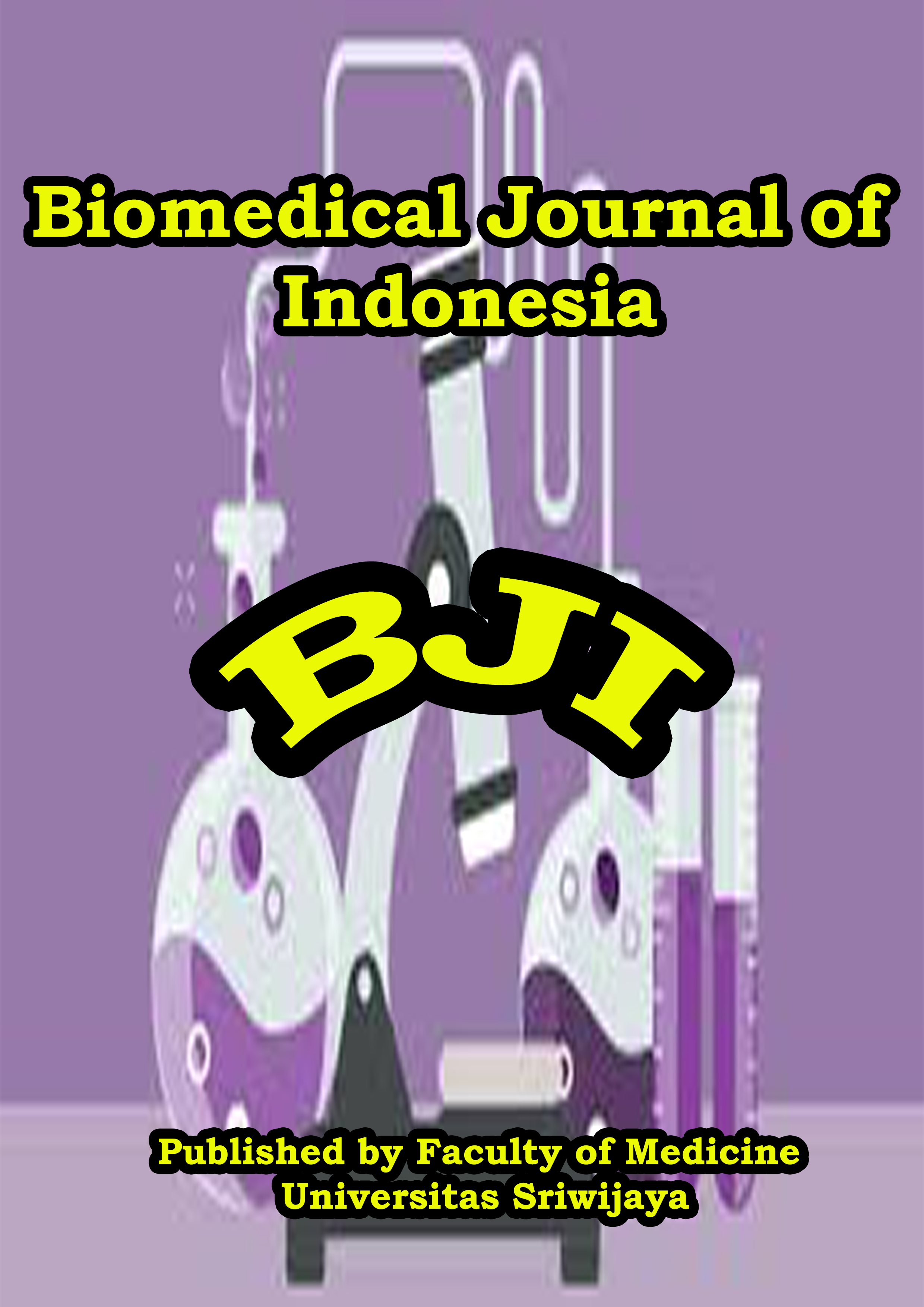Comparative Evaluation of Electrochemiluminescence and Chemiluminescence Microparticle Immunoassays for Anti-Hepatitis C Virus (HCV) Detection
Main Article Content
Introduction. Anti-hepatitis C virus (HCV) testing is an immunological analysis designed to identify the presence of antibodies against the HCV antigen. This investigation is typically conducted using the chemiluminescence immunoassay (CLIA) technique, which yields precise results. Current research attempts to evaluate the outcomes of the anti-HCV test utilizing the Chemiluminescence Microparticle Immunoassay (CMIA) and the Electrochemiluminescence Immunoassay (ECLIA) approaches. Methods. This cross-sectional study comprised 63 serum samples collected via consecutive sampling. The acquired data were subjected to statistical analysis utilizing Cohen's Kappa agreement test. Results. Both immunoassay methods yielded identical results, indicating four reactive samples out of 63, equating to 6.35%. The agreement test result for the anti-HCV test was κ=1.000, signifying an almost perfect level of agreement. Conclusion. The anti-HCV assessment utilizing CMIA and ECLIA methodologies demonstrated near-perfect agreement. This signifies that these two procedures can be employed in clinical laboratories concurrently or interchangeably for the test.
2. Orth M, Averina M, Chatzipanagiotou S, Faure G, Haushofer A, Kusec V, et al. Opinion: redefining the role of the physician in laboratory medicine in the context of emerging technologies, personalised medicine and patient autonomy ('4P medicine’). J Clin Pathol. 2019;72(3):191–7.
3. Weber MC, Risch M, Thiel SL, Grossmann K, Nigg S, Wohlwend N, et al. Characteristics of Three Different Chemiluminescence Assays for Testing for SARS-CoV-2 Antibodies. Dis Markers. 2021;2021:8810196.
4. Ma X, Wang R, Wei L, Liu P, Jing L, Wang J, et al. A comparison of chemiluminescent immunoassay and enzyme-linked immunosorbent assay for detecting phospholipase A2 receptor antibody in primary membranous nephropathy. Pract Lab Med. 2024;39:e00385.
5. Shaji LK, Sujatha SR, Deepashree R, Tejashree A, Satyasai B. Comparative evaluation of chemiluminescence immunoassay and immunochromatograhic test with ELISA for detection of HCV infection. Int J Health Sci (Qassim). 2022;6(S9):3044–53.
6. Schillie S, Wester C, Osborne M, Wesolowski L, Ryerson AB. CDC Recommendations for Hepatitis C Screening Among Adults - United States, 2020. Morb Mortal Wkly Rep. 2020;69(2):1–17.
7. Gaballah AM, Esawy MM. Comparison of 2 different antibody assay methods, Elecsys Anti-HCVII (Roche) and Vidas Anti-HCV (Biomerieux), for the detection of antibody to hepatitis C virus in Egypt. Diagn Microbiol Infect Dis. 2018;92(2):107–11.
8. Kesli R, Ozdemir M, Kurtoglu MG, Baykan M, Baysal B. Evaluation and comparison of three different anti-hepatitis C virus antibody tests based on chemiluminescence and enzyme-linked immunosorbent assay methods used in the diagnosis of hepatitis C infections in Turkey. J Int Med Res. 2009;37(5):1420–9.
9. Serdarevic N, Smajić J. Comparison of chemiluminescent microparticle immunoassay (CMIA) with electrochemiluminescence immunoassay (ECLIA) for Carcinoembryonic antigen (CEA). J Heal Sci. 2018;8(2):94–100.
10. Liana P, Fertilita S, Amalia E, Larasati V, Rasyid R, Zulissetiana E, et al. Anti-SARS-CoV-2 spike receptor binding domain (S-RBD) IgG antibodies following CoronaVac administration: a longitudinal study. Anti-SARS-CoV-2 S-RBD IgG antibodies. Med Immunol. 2023;25:215–22.
11. Liana P, Jenica A, Suciati T, Rahmawati E, Pariyana P, Umar TP. Comparison of Liver Function Test Results between Architect C8000 and COBAS C501 Automatic Chemistry Analyzer. Arch Razi Inst. 2023;78(3):1141–6.
12. McHugh ML. Interrater reliability: the kappa statistic. Biochem medica. 2012;22(3):276–82.
13. Mbisa JL, Lapp Z, Bibby DF, Phillips LT, Manso CF, Packer S, et al. Identification of 2 Novel Subtypes of Hepatitis C Virus Genotype 8 and a Potential New Genotype Successfully Treated With Direct Acting Antivirals. J Infect Dis. 2024;jiae253.
14. Ashfaq UA, Javed T, Rehman S, Nawaz Z, Riazuddin S. An overview of HCV molecular biology, replication and immune responses. Virol J. 2011;8(1):161.
15. Nie D, Shan X, Nie L, Duan Y, Chen Z, Yang Y, et al. Hepatitis C virus core protein interacts with Snail and histone deacetylases to promote the metastasis of hepatocellular carcinoma. Oncogene. 2016;35(28):3626–35.
16. El Omari K, Iourin O, Kadlec J, Sutton G, Harlos K, Grimes JM, et al. Unexpected structure for the N-terminal domain of hepatitis C virus envelope glycoprotein E1. Nat Commun. 2014;5(1):4874.
17. Jiang X, Chang L, Yan Y, Ji H, Sun H, Guo F, et al. A study based on four immunoassays: Hepatitis C virus antibody against different antigens may have unequal contributions to detection. Virol J. 2021;18(1):137.
18. Uliana C V, Riccardi CS, Yamanaka H. Diagnostic tests for hepatitis C: recent trends in electrochemical immunosensor and genosensor analysis. World J Gastroenterol. 2014;20(42):15476–91.
19. Warkad SD, Song KS, Pal D, Nimse SB. Developments in the HCV Screening Technologies Based on the Detection of Antigens and Antibodies. Sensors. 2019;19(19):4257.
20. Ghany MG, Morgan TR, panel A hepatitis C guidance. Hepatitis C guidance 2019 update: American Association for the Study of Liver Diseases–Infectious Diseases Society of America recommendations for testing, managing, and treating hepatitis C virus infection. Hepatology. 2020;71(2):686–721.
21. Fiedler SA, Oberle D, Chudy M, Scheiblauer H, Henseler O, Halbauer J, et al. Effectiveness of blood donor screening by HIV, HCV, HBV-NAT assays, as well as HBsAg and anti-HBc immunoassays in Germany (2008-2015). Vox Sang. 2019;114(5):443–50.
22. Mahmud S, Akbarzadeh V, Abu-Raddad LJ. The epidemiology of hepatitis C virus in Iran: Systematic review and meta-analyses. Sci Rep. 2018;8(1):150.
23. Kuehlkamp VM, Schneider IJC, Biudes MF, Galato D, Silva J da, Maurici R, et al. Factors associated with hepatitis C seropositivity in people living with HIV. Rev Panam salud publica. 2014;35(1):53–9.
24. Zocca E, Seraceni S, Cafaro T, Cervone TE, Cardarelli L, Valisi M, et al. Evaluation of Two-Assay Serological Testing Strategies for Anti-HCV Screening in Italian Populations: A Dual Screening Approach. Diagnostics. 2024;14(6):570.
25. Wadood M, Usman M. Comparative Analysis of Electrochemiluminescence Assay and Chemiluminescent Microparticle Immunoassay for the Screening of Hepatitis C. Indian J Hematol blood Transfus. 2019;35(1):131–6.
26. Pereira FM, Bertollo LA, Zarife MAS. Comparison of two automated chemiluminescence tests for the detection of antibodies against the hepatitis C virus. Rev Pan-Amazônica Saúde. 2010;1:17–21.
27. Salem DDE, ElSayed HTaN. Evaluating the performance of two different chemiluminescence analyzers systems in screening donors’ samples for HCV infection. Egypt Liver J. 2024;14(1):51.

